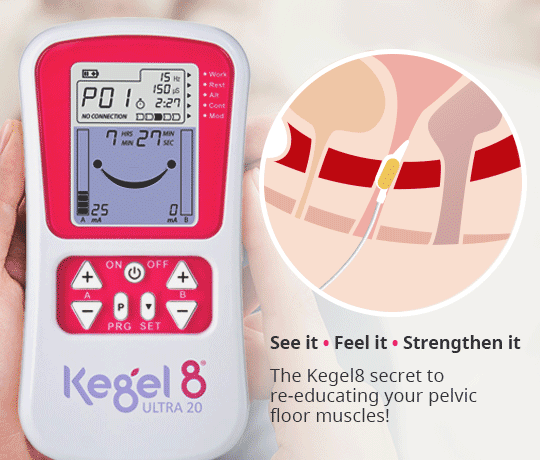
Your pelvic floor is one of the most important parts of your body. It's a collection of muscles, fibres and ligaments that work together to support your pelvic organs.
Keeping these muscles strong influences a lot of bodily functions, including:
- Sexual function
- Pregnancy and childbirth
- Posture and support
- Continence
- Bowel movements
The main way of keeping these muscles strong is to perform Kegels (pelvic floor exercises). These are exercises that work by contracting and relaxing the pelvic floor muscles.
How can you strengthen the pelvic floor without Kegels?
1. Correct your posture
The posture of your body changes the way your muscles work. If you’re sitting slumped, it’s hard for your muscles to do anything to help you. If you sit straighter, holding your head and neck up better, your abdominal muscles can work very quietly and your pelvic floor is not as switched off and out of action.
When standing, if your posture is poor, you can end up tilting your pelvis, again influencing how you muscles work. When standing with correct posture, all of your core muscles, your abs, glutes, pelvic floor and legs can work in a better balance.
Physiotherapist, Amanda Savage, advises that: “Your best posture is your next posture. Anything you’re doing, you should be doing for a short while and then move onto doing something else in a different posture. Keeping moving is a really simple tip to adopt.”
2. Learn breathing techniques
Breathing is something that comes completely natural to us. As your diaphragm moves, so should the pelvic floor.
Your pelvic floor is a support shelf, not a rigid structure, meaning it can move up and down with us. As we breathe in, the pelvic floor comes down. As we relax, it comes back up. It mimics the movements of your lungs and diaphragm.
Although completely natural to us, breathing can cause problems for the pelvic floor. When Kegel exercising for example, we tend to hold our breath when concentrating. But simultaneously, we are holding our pelvic floor. This can make the whole relationship between breathing and the pelvic floor very rigid.
If you’re struggling to focus on your breathing when Kegeling, try relaxing your muscles completely as you breathe in. Then as you breathe out, contract your muscles up – this will be easier as the muscles naturally go upwards when breathing out anyway.
3. Clear your cough
When you’re suffering from a cold or a bad cough, it’s important to ensure that the pressure of the cough is taken off the bladder. If you’re coughing all day, your pelvic floor will start to get tired, and you may then start to suffer from little leaks.
If you’re going to cough, and you know it’s coming, sit down. The surface of the chair will be able to provide some support to your pelvic floor.
If you’re suffering from one of those coughs where it takes you a good 20 attempts to shift a bit of phlegm from your lungs, it’s worth trying the ‘active cycle of breathing’ technique.
The tubes of your lungs actually go sideways. So, if you feel something sitting in the bottom of your lung, it’s got to go around right angles to get out of your throat. Follow the steps below and see if this technique helps:
- Try and figure out which side of your lung it is sitting it, and then lay on your side for a few minutes. This should allow the phlegm to trickle down from the lung into the back of the throat.
- Whilst on your side, take a few deep breaths.
- When you feel the cough brewing, try to hold it back, and instead perform a huff (i.e. like you’re trying to steam up a mirror).
- Perform one big cough and that should bring the phlegm that last distance from there out.
4. Hip circles
This exercise is great for overactive pelvic floor muscles as it simultaneously stretches and strengthens your muscles.
Shifting your pelvis in large circular motions can not only lengthen and tone the muscles of the pelvic floor, but it also works out the entire hip and core region.
5. Use an electronic toner
Exercising your pelvic floor can be difficult, especially when you don’t know whether you’re doing it properly. Using an electronic pelvic floor toner can remove all of the guesswork.
Using electrical stimulation may sound scary and dangerous, but it’s not at all! Your body uses electrical impulses all of the time to send messages to nerves and muscles – an electronic pelvic toner, such as the Kegel8 Ultra 20 Electronic Pelvic Toner, uses the same technique.
The Kegel8 Ultra 20 Electronic Pelvic Floor Toner uses NMES (neuromuscular electrical stimulation) to send electrical impulses, via a probe or electrode pads, to the muscles of your pelvic floor in order to stimulate a contraction. These contractions exercise the pelvic floor muscles automatically, building strength and tone when performed regularly.
Your thoughts on the Kegel8 Ultra 20 Electronic Pelvic Toner
Mags - Fantastic product!
"I have been suffering with vulvodynia for 2 years and have tried everything on an endless list of self help. I am currently on medication which makes me tired and doesn't help very much. One of the things on the list was weak pelvic floor, so after research I found the Kegel8 Ultra 20. I am happy to say after using the Kegel for just 4 weeks I have been symptom free for 7 days. "
Caz - Excellent!
"I’m extremely impressed with this machine. After trying pelvic floor exercises for a year, with disappointing results, I decided to splash out on a Kegel8 Ultra 20. I have only been using the device for a month but have seen a definite improvement already. I was mortified and embarrassed when my pelvic floor was weakened and wish I’d have known about Kegel8 at the beginning."





